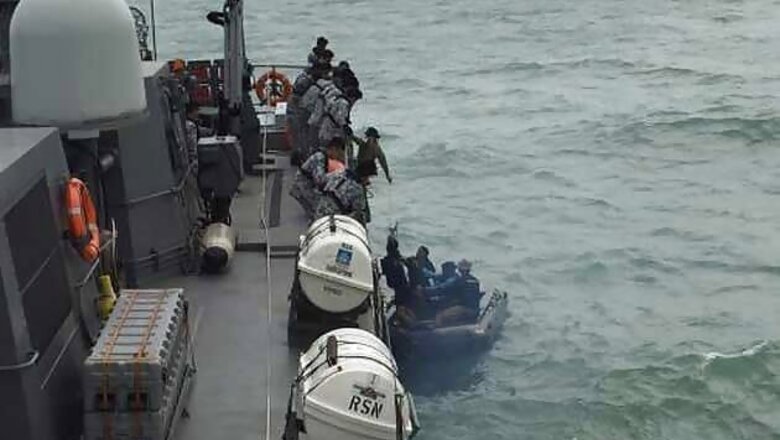
views
Surabaya: Divers tried to reach sunken wreckage from a crashed AirAsia passenger jet on Sunday but were forced to return to their ship by bad weather, as Indonesian officials said they had detected a fifth large underwater object believed to be part of the plane.
Indonesia's meteorological agency has said seasonal tropical storms probably contributed to the crash, and the weather has persistently hampered efforts to recover bodies and find the black box flight recorders that may explain why the Airbus A320-200 plunged into the sea a week ago.
"The weather is bad. There's a storm. It's windy," said an eyewitness.
"Earlier, four divers were transferred to (Indonesian navy ship) KRI Banda Aceh but they canceled the diving because the sea currents were too strong."
Flight QZ8501 crashed into the Java Sea last Sunday, about 40 minutes after taking off from Indonesia's second-largest city Surabaya en route for Singapore. There were no survivors.
Indonesian officials were hopeful of a breakthrough in the operation when they announced on Saturday that ships using sonar had pinpointed four large pieces of debris on the sea bed.
The head of Indonesia's search and rescue agency, Fransiskus Bambang Soelistyo, told a news conference in Jakarta on Sunday that a fifth object almost 10 meters long had been found.
But although nine ships from four countries have converged on the area, with teams of divers including seven Russian experts standing ready, winds and high waves have meant progress has been agonizingly slow.
Weather likely a factor
Air Force Lt Col Johnson Supriadi, speaking at a briefing for pilots in Pangkalan Bun, the southern Borneo town where the search operation is based, said efforts on Sunday would be divided between recovering bodies and locating wreckage and the all-important cockpit voice and flight data recorders.
Until investigators can examine the recorders the cause of the crash remains unknown, but the area is known for intense seasonal storms. BMKG, Indonesia's meteorological agency, has said bad weather was likely a factor.
"The flight document provided by the BMKG office shows fairly worrying weather conditions for the aircraft at cruising level on the chosen route," the agency said in a report.
A source close to the investigation told Reuters that radar data appeared to show the aircraft made an "unbelievably" steep climb before it crashed, possibly pushing it beyond the A320's limits.
The Indonesian captain, a former air force fighter pilot, had 6,100 flying hours on the A320 and the plane last underwent maintenance in mid-November, according to Indonesia AirAsia, 49 percent owned by Malaysia-based AirAsia.
Shallow water
The objects that are the main focus of the search were located by ships about 90 nautical miles off the coast. The largest object is around 18 meters long.
The suspected wreckage is lying in water around 30 meters (100 ft) deep, which experts say should make it relatively straightforward to recover if the rough weather abates.
Efforts to capture images with remote operated vehicles (ROVs) were frustrated on Saturday by poor visibility.
Thirty-one bodies of the mostly Indonesian passengers and crew have so far been recovered, including some still strapped in their seats. Many more may be still trapped in the fuselage of the aircraft. Nine Indonesian victims have been identified.
The crash was the first fatal accident suffered by the AirAsia budget group, whose Indonesian affiliate flies from at least 15 destinations across the sprawling archipelago.
The airline has come under pressure from Indonesian authorities, who have suspended its Surabaya to Singapore operations saying the carrier only had a license to fly the route on Mondays, Tuesdays, Thursdays and Saturdays.
Indonesia AirAsia said it would co-operate with the transport ministry whilst it investigates the license.
A joint statement from Singapore's civil aviation authority (CAAS) and Changi Airport Group said that AirAsia had the necessary approvals to operate a daily flight between Surabaya and Singapore.




















Comments
0 comment